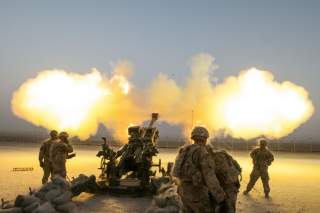A Conservative Defense Policy for 2014: Look to Eisenhower
"The United States simply cannot be everywhere that it needs to be with the high-cost/low-numbers military it currently plans, and Republicans cannot simply choose to deficit spend on defense or any other programs they admire."
Recent discussions amongst Republicans regarding U.S. Defense force structure have revealed an ongoing disagreement between two camps within the party. Military Hawks, citing the recent disturbances in Ukraine and Iraq, have begun to beat the drum for more resources to be allocated for the Department of Defense to address threats that never really subsided. Fiscal Hawks, focused on budget deficits that stretch as far as the eye can see, continue to argue for DoD to continue to be part of a basket of cuts in entitlements and discretionary programs. While all agree that the United States needs to maintain a military strong enough to deter the rise of competitors and preserve its ability to respond to crises around the world, the question that remains is: how large and how capable does our military have to be to accomplish these twin goals?
The Military Hawks’ solution is to increase spending and buy more weapons already in production from our military industrial base. Fiscal Hawks, arguing that our Department of Defense is larger than the next ten militaries combined, believe there is room for continued cuts before the nation’s interests are placed at risk. Objective analysis suggests that a path exists that would allow cuts to the DoD budget and marginal growth in the force. Such a path is predicated on recognizing that our national fascination with high-tech weapons systems has led to a defense culture where the exquisite has become the enemy of the “good enough.”
It has not been so long since the Chairman of the Joint Chiefs of Staff pronounced that our debt posed a grave threat to our national security at home and around the world. Projected annual trillion-dollar deficits have not lessened the American people's concern. The Budget Control Act (or Sequester) was passed with a false assumption that its provisions would be so painful that the Congress would have to agree on a thoughtful deficit-cutting solution. While we can all agree that it would be wise and desirable to escape the painful controls imposed by the Sequester, we should not give way to election-year desires to spend more, ignoring the long-term implications of our debt.
Some compromise can be found that lowers the cost of entitlements and defense, while also increasing revenues. The Democrats need to come to the table to address the looming crises in Social Security and healthcare. Defense spending should continue downward to levels somewhat higher than those last seen prior to 9/11, when the Department of Defense had an inflation-adjusted budget of $386B (we spend $560B today), the Army had 481,000 soldiers (522,000 today) and the Navy had 316 ships (291 currently). In 2001, we stated that we could fight two major regional conflicts; today, we admit that is no longer possible. Why has the cost of our military gone up 45 percent, while its ability to fight has gone down? Healthcare costs have risen, and there have been complications associated with fighting two wars, but even after factoring the current ISIS crisis into the equation, the wartime pressures are subsiding. In the end, a major inflationary pressure remains our addiction to exquisite platforms.
It is unwise to accept the false premise that we can only arrive at a larger force by spending more on the same types of platforms that we are already building. A conservative approach to the future must find the right balance between high-priced silver bullets that can only be purchased in small numbers and low technology assets that can be purchased in large quantities at low costs. Such an approach would be reminiscent of the Eisenhower presidency, when Ike addressed the debt that had been run up fighting World War II by pursuing a careful balance between a smaller conventional-fighting force and the newly emergent nuclear force, balancing the budget in the process. A Republican defense policy today should rest upon four legs: preservation of current high-tech capabilities, increased emphasis on the procurement of low-cost assets for day-to-day operations, modernization of our nuclear arsenal and investment in the research and development of new technologies to guarantee American leadership after our fiscal house is put in order.
In the meantime, in a world beset with constant turmoil, the phrase “quantity has a quality all its own” takes on new meaning. The United States simply cannot be everywhere that it needs to be with the high-cost, low-numbers military it currently plans, and Republicans cannot simply choose to deficit spend on defense or any other programs they admire. All government spending must be constrained. The turning point on defense will occur when we recognize that spending less money does not have to equate to a smaller force. Wise leaders have a credible alternative in defense-force structure and should pursue it.
Dr. Jerry Hendrix is a Senior Fellow at the Center for a New American Security (CNAS) and a retired Navy Captain.
Image: U.S. Department of Defense/Flickr.

